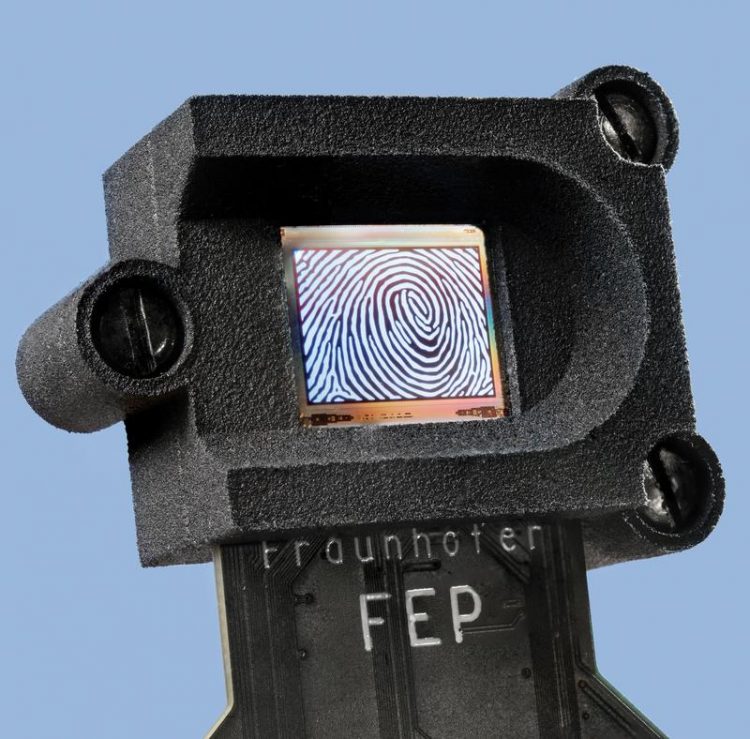OLED microdisplays as high-precision optical fingerprint sensors

High-resolution OLED-on-silicon fingerprint sensor © Fraunhofer FEP | Picture in printable resolution: www.fep.fraunhofer.de/press
Fraunhofer FEP has been developing various application-specific OLED microdisplays based on OLED-on-silicon technology successfully for many years. This unique technology enables the high-precision integration of an OLED as light source on a microchip. Moreover this microchip can be designed with further sensor elements, e.g. photodiodes.
By this, objects can be illuminated and at the same time the reflected light detected and analyzed. Such microdisplays can be integrated into interactive data eyeglasses as a “bi-directional microdisplay”: the tiny display projects the information for augmented-reality applications whereas the camera function detects the viewing direction– thus the content can be controlled by eye-movements.
The fingerprint sensor uses this bidirectional functionality of light-emission and –detection as well: the finger gets illuminated and the reflected light will be detected and analyzed.
Bernd Richter, deputy division manager for OLED microdisplays and sensors at Fraunhofer FEP explains: “We have used an extra-thin encapsulation for the chip of this fingerprint sensor. Thereby the distance between finger and image sensor has been minimized and the fingerprint can be captured excellently. Thus, an additional imaging optics is not necessary for this application.”
The first prototype has a native resolution of 1600 dpi – this is three times more than typically required by the FBI. This high spatial resolution enables the identification even of smallest sweat pores beside the typical papillary lines, which can be used to increase the security.
One of the most promising applications of this new kind of sensor is the user verification in mobile devices. Because of the particularly high resolution in comparison to the typically used capacitive fingerprint sensors these devices are much less vulnerable to so-called spoofing (the manipulation by “false fingers”).
Another nice side effect is the opportunity for using the active area as a normal display e.g. for branding, displaying logos or notifications.
Fraunhofer FEP at SID Display Week 2017
Symposium
Friday, May 26, 2017 / 10:40 am – 12:00 pm / room 515 a
Session 77: OLED Displays II (OLEDs)
Invited Paper:
Ultra-Low Power OLED Microdisplay for Extended Battery Life in Near-to-Eye Displays
Dr. Uwe Vogel, Fraunhofer FEP, Dresden, Germany
Poster Session
Thursday, May 25, 2017 / 05:00 – 8:00 pm / Petree Hall
P.175: Direct Electron-Beam Micropatterning and Thermal Annealing of OLED Devices
Elisabeth Bodenstein, Fraunhofer FEP, Dresden, Germany
Exhibitor-Forum
Thursday, May 25, 2017, West halls AB
Session F8: OLEDs (09:15 – 10:15 am)
F8.2: OLED Microdisplay with Embedded Optical Fingerprint Sensor
Peter König, Fraunhofer FEP, Dresden, Germany
F8.3: OLED Micropatterning by Electron Beam Ablation
Elisabeth Bodenstein, Fraunhofer FEP, Dresden, Germany
Press contact:
Mrs. Annett Arnold
Fraunhofer Institute for Organic Electronics, Electron Beam and Plasma Technology FEP
Phone +49 351 2586 452 | annett.arnold@fep.fraunhofer.de
Winterbergstraße 28 | 01277 Dresden | Germany | www.fep.fraunhofer.de
Media Contact
All latest news from the category: Trade Fair News
Newest articles

Bringing bio-inspired robots to life
Nebraska researcher Eric Markvicka gets NSF CAREER Award to pursue manufacture of novel materials for soft robotics and stretchable electronics. Engineers are increasingly eager to develop robots that mimic the…

Bella moths use poison to attract mates
Scientists are closer to finding out how. Pyrrolizidine alkaloids are as bitter and toxic as they are hard to pronounce. They’re produced by several different types of plants and are…

AI tool creates ‘synthetic’ images of cells
…for enhanced microscopy analysis. Observing individual cells through microscopes can reveal a range of important cell biological phenomena that frequently play a role in human diseases, but the process of…





















